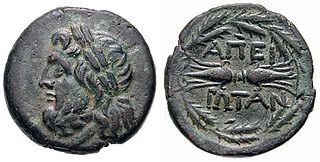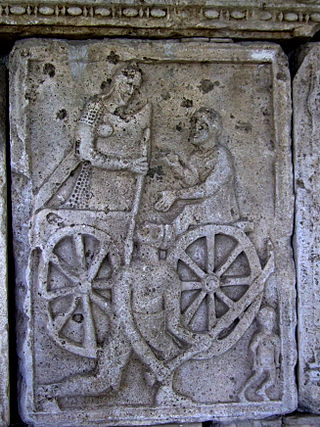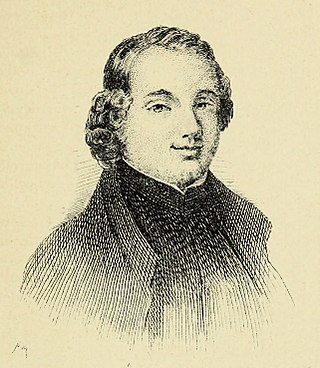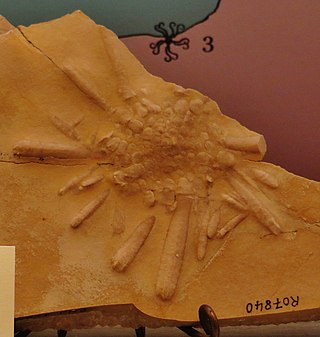
The three-age system is the periodization of human prehistory into three time-periods: the Stone Age, the Bronze Age, and the Iron Age, although the concept may also refer to other tripartite divisions of historic time periods. In history, archaeology and physical anthropology, the three-age system is a methodological concept adopted during the 19th century according to which artefacts and events of late prehistory and early history could be broadly ordered into a recognizable chronology. C. J. Thomsen initially developed this categorization in the period 1816 to 1825, as a result of classifying the collection of an archaeological exhibition chronologically – there resulted broad sequences with artefacts made successively of stone, bronze, and iron.

Ukko, Äijä or Äijö, parallel to Uku in Estonian mythology, is the god of the sky, weather, harvest, and thunder in Finnish mythology.

A thunderbolt or lightning bolt is a symbolic representation of lightning when accompanied by a loud thunderclap. In Indo-European mythology, the thunderbolt was identified with the 'Sky Father'; this association is also found in later Hellenic representations of Zeus and Vedic descriptions of the vajra wielded by the god Indra. It may have been a symbol of cosmic order, as expressed in the fragment from Heraclitus describing "the Thunderbolt that steers the course of all things".
Finnish mythology is a commonly applied description of the folklore of Finnish paganism, of which a modern revival is practiced by a small percentage of the Finnish people. It has many features shared with Estonian and other Finnic mythologies, but also shares some similarities with neighbouring Baltic, Slavic and, to a lesser extent, Norse mythologies.

Michele Mercati was a physician who was superintendent of the Vatican Botanical Garden under Popes Pius V, Gregory XIII, Sixtus V, and Clement VIII. He was one of the first scholars to recognise prehistoric stone tools as human-made rather than natural or mythologically created thunderstones.
Perkūnas was the common Baltic god of thunder, and the second most important deity in the Baltic pantheon after Dievas. In both Lithuanian and Latvian mythology, he is documented as the god of sky, thunder, lightning, storms, rain, fire, war, law, order, fertility, mountains, and oak trees.
Thunderstone or Thunder Stone may refer to:
Perëndi is an Albanian noun for God, deity, sky and heaven. It is used capitalized to refer to the Supreme Being, and uncapitalized for "deity", "sky" and "heaven".

Ukonvasara, or Ukonkirves, is the symbol and magical weapon of the Finnish thunder god Ukko, similar to Thor's Mjölnir. Ukonvasara means 'hammer of Ukko'; similarly, Ukonkirves means 'axe of Ukko'. It was said that Ukko created lightning with Ukonvasara.

The rhomphaia was a close-combat bladed weapon used by the Thracians as early as 350-400 BC. Rhomphaias were weapons with a straight or slightly curved single-edged blade. Although the rhomphaia was similar to the falx, most archaeological evidence suggests that rhomphaias were forged with straight or slightly curved blades, presumably to enable their use as both a thrusting and slashing weapon. The blade was constructed of iron and used a triangular cross section to accommodate the single cutting edge with a tang of rectangular cross section. Length varied, but a typical rhomphaia would have a blade of approximately 60–80 cm (24–31 in) and a tang of approximately 50 cm (20 in). From the length of the tang, it can be presumed that, when attached to the hilt, this portion of the weapon would be of similar length to the blade.
*Perkʷūnos is the reconstructed name of the weather god in Proto-Indo-European mythology. The deity was connected with fructifying rains, and his name was probably invoked in times of drought. In a widespread Indo-European myth, the thunder-deity fights a multi-headed water-serpent during an epic battle in order to release torrents of water that had previously been pent up. The name of his weapon, *ml̥dʰnis, which denoted both "lightning" and "hammer", can be reconstructed from the attested traditions.

Albanian folk beliefs and mythological stories comprise the beliefs expressed in the customs, rituals, myths, legends and tales of the Albanian people. The elements of Albanian mythology are of ancient Paleo-Balkanic origin and almost all of them are pagan. Albanian folklore evolved over the centuries in a relatively isolated tribal culture and society. Albanian folk tales and legends have been orally transmitted down the generations and are still very much alive in the mountainous regions of Albania, Kosovo, western North Macedonia, lands formerly inhabited by Albanians like Montenegro and South Serbia and among the Arbëreshë in Italy and the Arvanites in Greece.

Joseph-François Lafitau was a French Jesuit missionary, ethnologist, and naturalist who worked in Canada. He is best known for his use of the comparative method in the field of scientific anthropology, the discovery of ginseng, and his writings on the Iroquois. Lafitau was the first of the Jesuit missionaries in Canada to have a scientific point of view. Francis Parkman praises Lafitau, stating, "none of the old writers are so satisfactory as Lafitau."

An axe is an implement that has been used for millennia to shape, split, and cut wood, to harvest timber, as a weapon, and as a ceremonial or heraldic symbol. The axe has many forms and specialised uses but generally consists of an axe head with a handle, also called a haft or a helve.

In English folklore, elf-arrows, elf-bolts and pixie arrows were names given to discovered arrowheads of flint, used in hunting and war by the Pre-Indo-Europeans of the British Isles and of Europe generally. The name derives from the folklore belief that the arrows fell from the sky, and were used by the elves to kill cattle and inflict elf-shot on human beings.
The drangùe is a semi-human winged divine hero in Albanian mythology and folklore, associated with weather and storms. Babies destined to become drangue are born with their heads covered in caul and with two or sometimes four wings under their arms. The drangue hold supernatural powers, especially in the wings and arms. A drangùe is made invulnerable by the singular conjunction produced at his birth, and can die only if this conjunction is repeated once again. The main goal of the drangue is to fight the kulshedra in legendary battles. He uses meteoric stones, lightning-swords, thunderbolts, piles of trees and rocks to defeat the kulshedra and to protect mankind from storms, fire, floods and other natural disasters caused by her destructive power. Heavy thunderstorms are thought to be the result of their battles. The drangue and their myth are extensively and accurately portrayed in the Albanian folk tale "The Boy who was Brother to the Drague".

In Slavic mythology, Perun is the highest god of the pantheon and the god of sky, thunder, lightning, storms, rain, law, war, fertility and oak trees. His other attributes were fire, mountains, wind, iris, eagle, firmament, horses and carts, and weapons. The supreme god in the Kievan Rus' during the 9th-10th centuries, Perun was first associated with weapons made of stone and later with those of metal.

Anglo-Saxon Amulets and Curing Stones is an archaeological study of amulets, talismans and curing stones in the burial record of Anglo-Saxon England. Written by the Australian archaeologist Audrey Meaney, it was published by the company British Archaeological Reports as the 96th monograph in their BAR British Series. Prior to writing the work, Meaney had published several books dealing with Anglo-Saxon burials.

Echinoid fossils are the fossilised remains of sea urchins, spiny marine invertebrates that live on the seabed. Humans have been interested in these fossils for millennia, have considered them lucky, have imbued them with magical powers and linked them to their deities.















